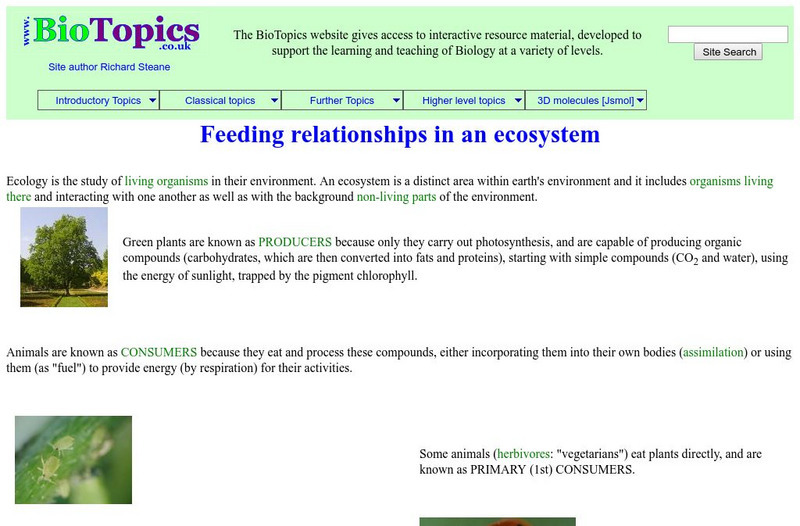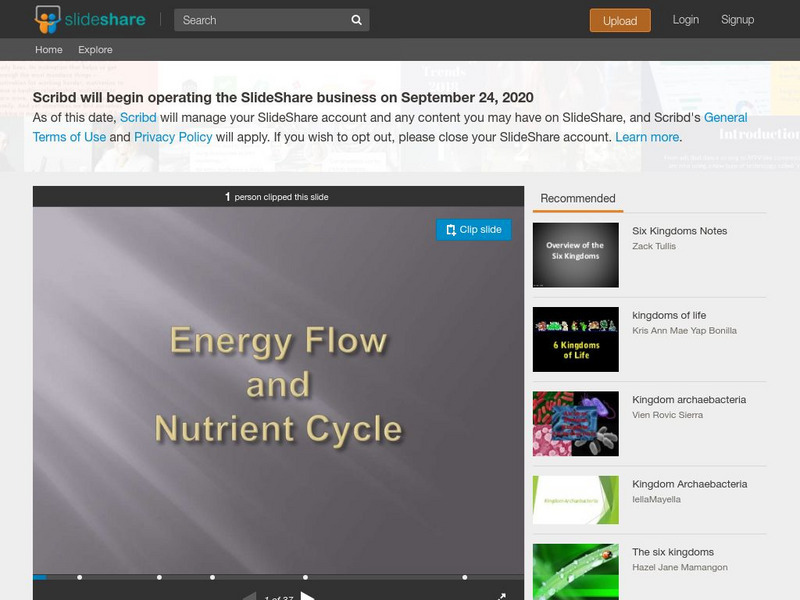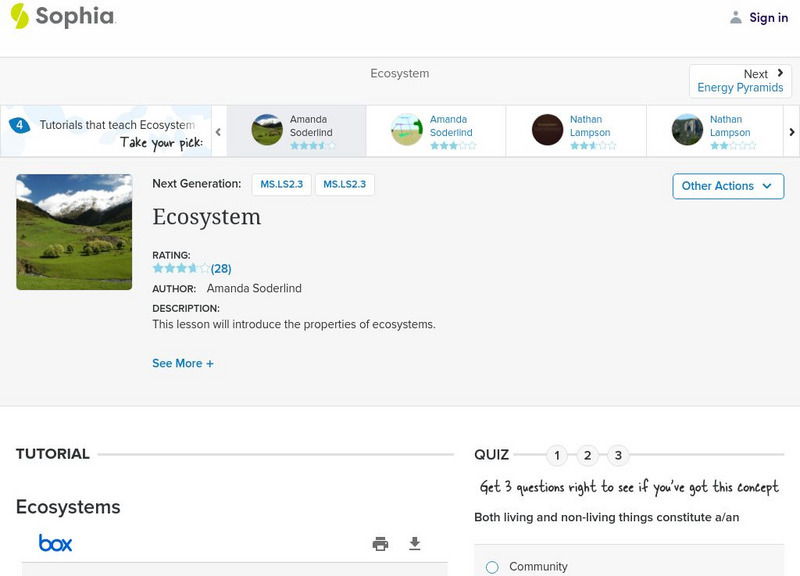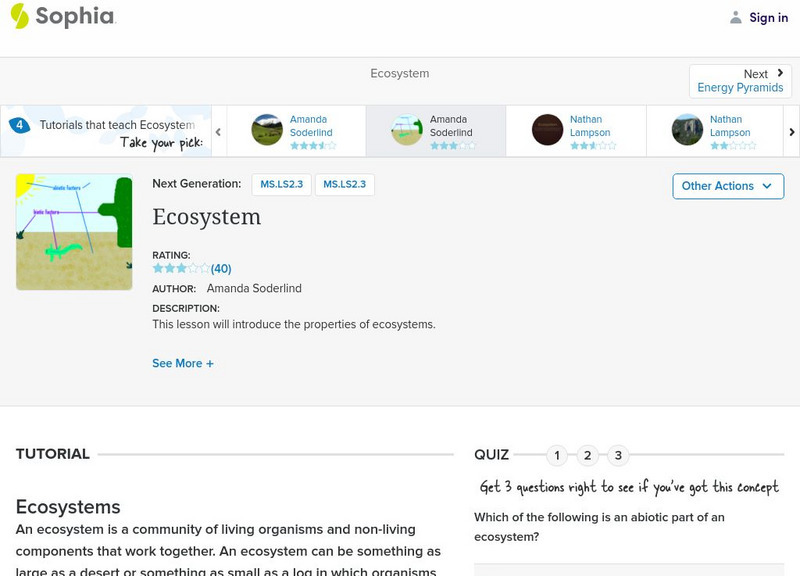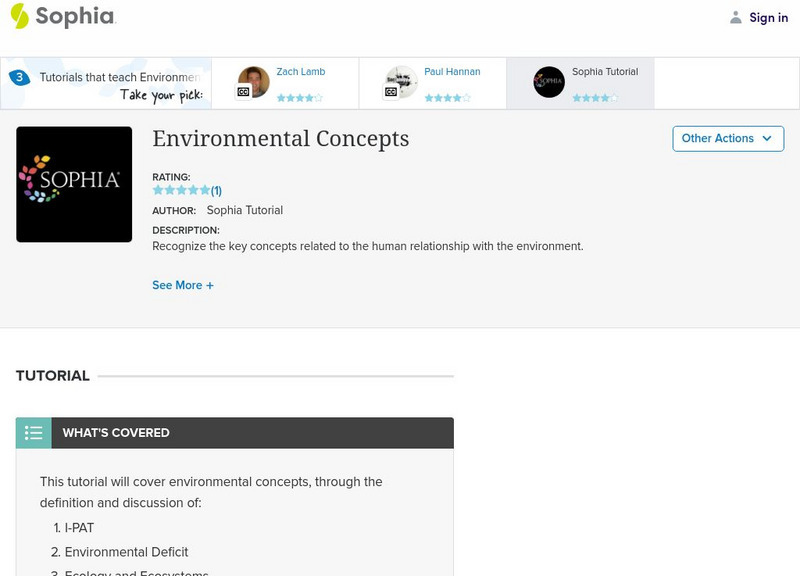Hi, what do you want to do?
Bio Topics
Bio Topics: Feeding Relationships in an Ecosystem
This overview of feeding relationships illustrates to students the trophic levels of different organisms in an ecosystem. Hover the mouse over different terms to see their definitions.
Sophia Learning
Sophia: Abiotic and Biotic Factors: Lesson 4
This lesson will introduce abiotic and biotic factors, giving examples and comparing/contrasting the two. It is 4 of 4 in the series titled "Abiotic and Biotic Factors."
Sophia Learning
Sophia: Abiotic and Biotic Factors: Lesson 1
This lesson will introduce abiotic and biotic factors, giving examples and comparing/contrasting the two. It is 1 of 4 in the series titled "Abiotic and Biotic Factors."
Ducksters
Ducksters: Science for Kids: Carbon Cycle
Kids learn about the carbon cycle and how this nutrient travels through the ecosystem to sustain life on Earth.
Ducksters
Ducksters: Science for Kids: Coral Reef Biome
Kids learn about the coral reef biome. Much of ocean life lives in this important aquatic ecosystem.
Ducksters
Ducksters: Science for Kids: Desert Biome
Kids learn about the desert biome. The dryest areas on Earth still have plant and animal life.
Ducksters
Ducksters: Science for Kids: Marine or Ocean Biome
Kids learn about the marine biome. The largest biome by far, the oceans cover most of the Earth's surface.
Other
Cefas: Our Science
A website focusing on the research done by the Center for Environment, Fisheries, and Aquaculture science that focuses on climate change, marine planning, fisheries management, and sustainability. Website includes information about...
The Environmental Literacy Council
Environmental Literacy Council: Ecosystems
Article explaining ecosystems and why we use them to organize our ideas about the natural world. Links to additional resources, maps, and activities.
ClassFlow
Class Flow: Understanding Ecosystems
[Free Registration/Login Required] This flipchart will help students to learn about ecosystems and the living and nonliving things that interact in them.
ClassFlow
Class Flow: Understanding Ecosystems: Part 1 of 4
[Free Registration/Login Required] Students will get an introduction to ecosystems. They will be able to distinguish nonliving and living thins in a habitat.
ClassFlow
Class Flow: Ecosystems
[Free Registration/Login Required] This flipchart explores the different ecosystems of the world, enhanced by embedded videos showing both the landscape and the plants and animals that can be found there.
ClassFlow
Class Flow: Energy in Ecosystems Habitat
[Free Registration/Login Required] This flipchart discusses the habitats in ecosystems.
Tom Richey
Slide Share: Energy Flow and Nutrient Cycle
Read 37 slides on energy flow and the nutrient cycle.
Sophia Learning
Sophia: Ecosystem
A PowerPoint giving a basic definition of an ecosystem. Also explained with a definition and examples are abiotic and biotic factors of the ecosystem.
Other
Open2.net: Ecosphere
Designed by the Open University and the BBC, this website from Open2.net explores ecosystems. Included is a lengthy discussion on closed ecosystems and their importance to research, as well as a virtual ecosystem, an interactive showcase...
Annenberg Foundation
Annenberg Learner: Ecology Lab
Build your own ecosystem, and explore the effects of these interrelationships.
Sophia Learning
Sophia: Ecosystems
Gives basic information about the community that forms between living and non-living factors that function together in an ecosystem. [47 secs]
Science Struck
Science Struck: The 6 Chief Levels of Organization in Ecology
Describes six levels of organization in the biological world - individual species, population, community, ecosystem, biome, and biosphere.
ClassFlow
Class Flow: Ecosystems
[Free Registration/Login Required] A flipchart covering the concepts and ideas required to understand ecosystems, with particular concentration on the tropical rain forest.
Sophia Learning
Sophia: Environmental Concepts
This lesson will discuss the key concepts related to the human relationship with the environment.
PBS
Nh Pbs: Nature Works: Ecosystems
How would you define an ecosystem? Check out this educational resource to learn more about the living and nonliving parts of different ecosystems.
US Geological Survey
Usgs: Desert Ecosystems
What elements are present in a desert ecosystem? What impact might humans have upon it? Learn more about the processes that affect desert ecosystems by visiting this site. Contains only one large illustration.
The Franklin Institute
Franklin Institute: Ecosystems, Biomes, and Habitats
This site is provided for by The Franklin Institute Online. "Open the door and step into your ecosystem." Content describes ecosystems and related material such as biomes, habitats, energy cycle, extinction, recycling, and more.





